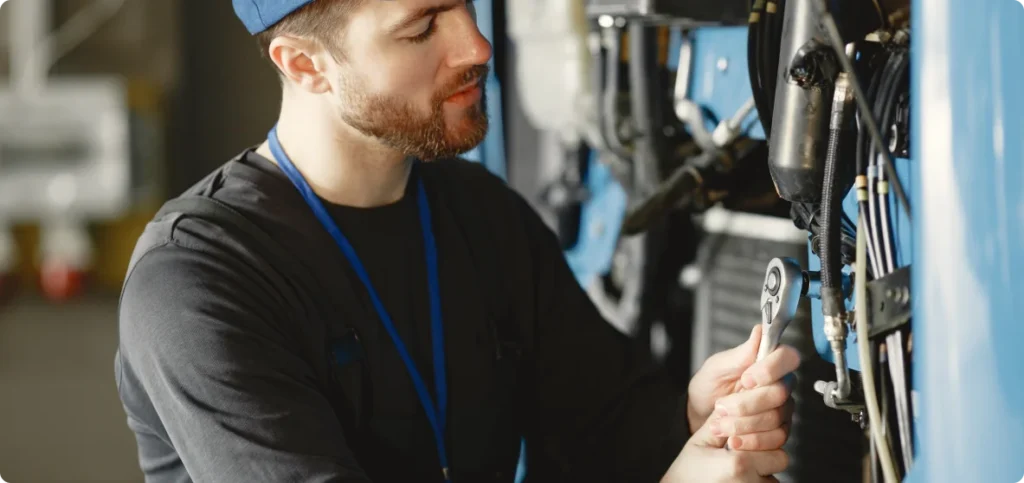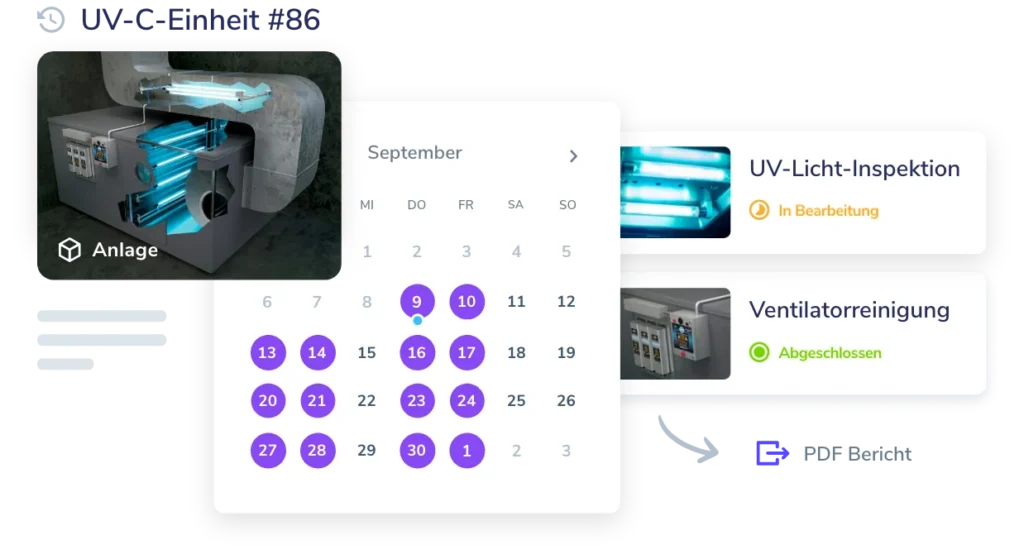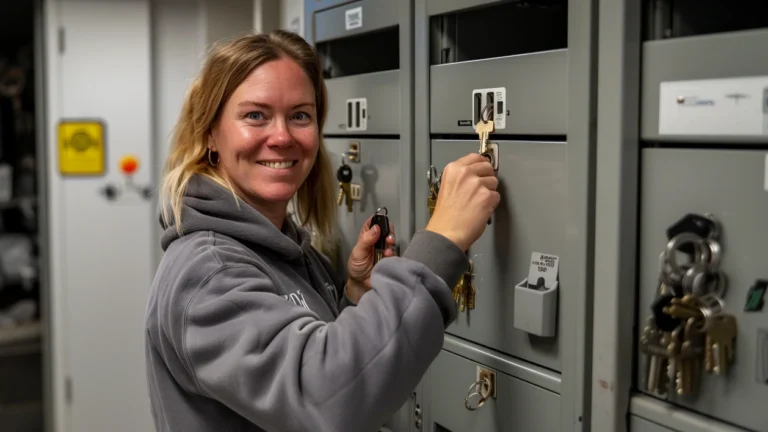Proper maintenance is the secret to long-lasting equipment performance and a key factor in reducing running costs and total downtime. Maintaining the functionality of equipment and assets is the foundation of facilities management, but what does it take to organize an optimal maintenance process?
In this guide, we look at different types of maintenance, the essential tasks for the most commonly used equipment, industry-specific practices and the role of maintenance staff. We will demonstrate how modern tools and innovative technologies such as automation, the Internet of Things (IoT) and AI-based predictive analytics are driving development and redefining maintenance trends.
- Understanding the different types of maintenance is an essential building block for proper equipment servicing and overall running costs optimization.
- Professional maintenance is the backbone of facilities management, it ensures that all of the company’s physical assets function reliably and are used optimally
- Maintenance software is a vital instrument in facilities management, which is required for planning important maintenance and repair work
- Automation, IoT and AI are revolutionizing modern maintenance practices by increasing efficiency, accuracy and productivity in asset management.
What is maintenance, and why is it important?
Maintenance generally refers to the routine work that is carried out to ensure the safety, optimum performance and assets, equipment or systems.
It can include preventive activities such as inspections, cleaning, lubrication or minor repairs aimed at preventing premature wear or breakdowns.
The importance of maintenance extends across many industries, as every division, that uses equipment or machinery, must have professional maintenance strategies. Some of the examples we can name include the automotive industry, aerospace, medical technologies, power supply and food production.
In facilities management, there is a whole variety of maintenance work to be done. It often includes regular inspections of the heating, ventilation and air conditioning systems, as well as elevator servicing and repairs of the electrical system.
Investing in good maintenance practices allows companies to avoid costly repairs, reduce downtime and increase staff productivity. Regular maintenance also helps to identify potential problems and address them before they cause any accidents and injuries.
By maximizing efficiency through regular maintenance, companies can also reduce energy consumption and improve sustainability.
The difference between maintenance and servicing
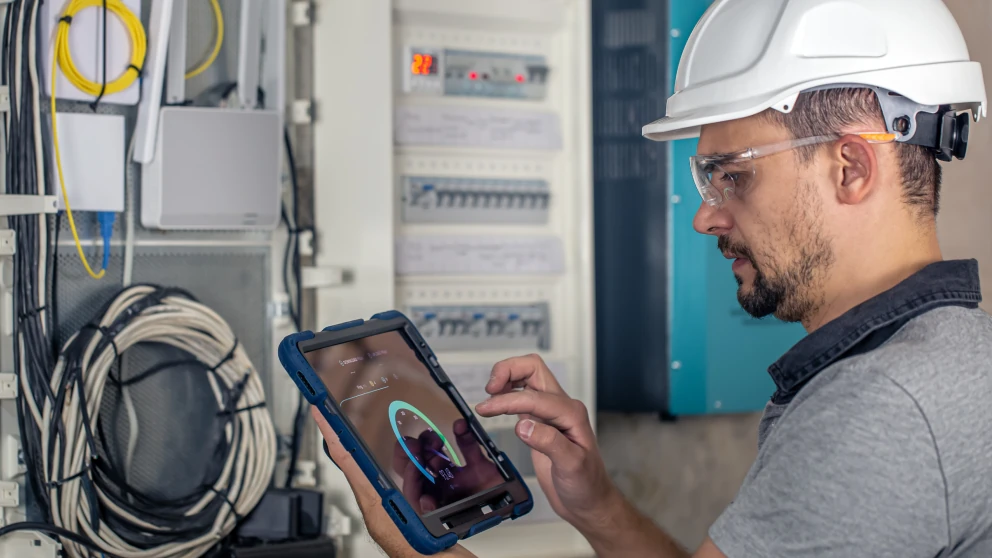
Servicing and maintenance are two terms that are often used interchangeably, but they actually have different meanings, especially in the technical or industrial context.
Maintenance generally refers to routine checks and work on assets, machines or systems in order to maintain their functionality and keep up their performance.
Servicing, on the other hand, is more extensive and includes measures aimed not only to ensure the preservation but also the restoration of a system or equipment and its functionality. This can include major repairs, the replacement of parts, or even an entire overhaul of the system.
Maintenance and servicing together ensure that equipment and systems work safely, reliably and efficiently.
Understanding different types of maintenance
Understanding the different types of maintenance is key to keeping equipment in top condition while reducing maintenance expenses. There are three main types of maintenance work: preventive, corrective and predictive maintenance. Each type of maintenance serves a specific purpose to ensure that the equipment functions smoothly and efficiently.
Here you will find a detailed analysis of these types.
Preventive maintenance
Preventive maintenance focuses on carrying out regular inspections and maintenance work to prevent device failures and extend their service life. This type of maintenance includes:
- Regular partial or complete overhauls
- Oil change
- Lubrication
- Minor adjustments
The goals of preventive maintenance are:
- To ensure equipment operation is preserved between scheduled maintenance periods without failure because of to fatigue, neglect or normal wear and tear
- To reduce downtime
- To increase productivity
- To extend the service lifecycle of devices
All of these benefits can be achieved by introducing preventive maintenance into the strategy of the company.
Corrective maintenance
In contrast to preventive maintenance, corrective maintenance focuses on repairing and replacing damaged components after a fault has already occurred. The corrective maintenance process includes the following:
- Repairing and/or replacing defective parts
- Disassembling and analysing components
- Repairing worn parts
- Restoring the optimal operating state of devices or systems
Corrective maintenance, which is usually reactive, is carried out after a system failure or malfunction and aims to restore the system’s performance.
Predictive maintenance
Predictive maintenance is a technique that uses data analysis and monitoring tools to predict equipment failures and plan maintenance activities accordingly. This enables companies to keep their machines at an optimum performance level.
This proactive approach not only helps to prevent breakdowns of specialized equipment, but also enables a more efficient maintenance work and resource allocation process.
Essential maintenance tasks for commonly used devices
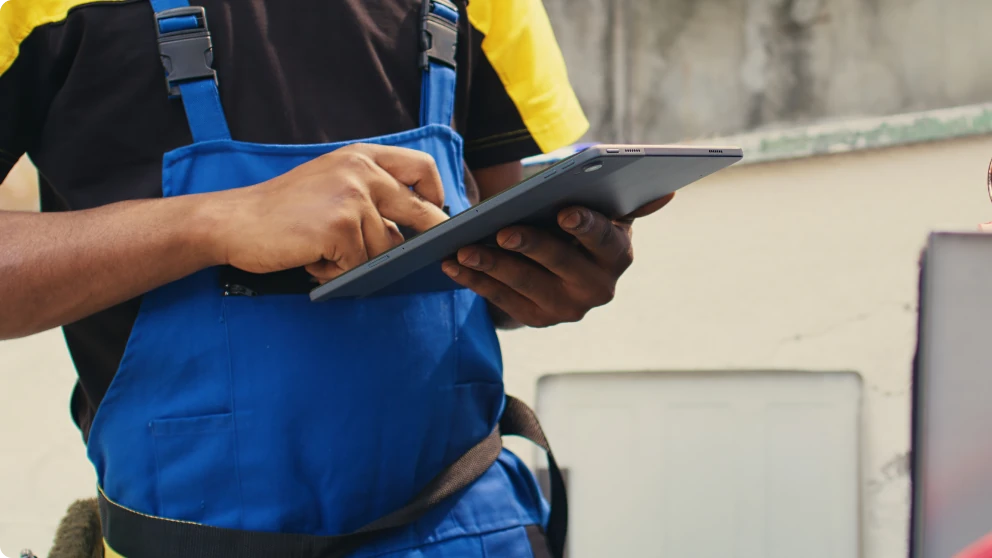
Carrying out crucial maintenance work on common appliances such as air conditioning, heating and electrical systems is vital in ensuring their smooth operation. These tasks help to ensure that the devices function properly and can prevent costly breakdowns.
Here you will find an overview of the maintenance tasks for these widely used systems.
Maintenance of air conditioning systems
Regular maintenance is essential to ensure optimum performance and energy efficiency of an air conditioning system. A key component that requires maintenance is the air conditioning unit itself. Routine tasks include:
- Replacing or cleaning air filters
- Checking and adjusting the thermostat
- Tightening all electrical connections
- Inspection of the refrigerant lines
- Cleaning the condenser coils
Performing these tasks regularly will help to prevent common problems such as air conditioning failures, refrigerant leaks and frozen coils, which can increase energy consumption.
Heating system maintenance
A regular checkup of the heating system is necessary to maintain a comfortable indoor environment and avoid breakdowns. A heating system maintenance template should include the following tasks:
- Replacing the filter
- Removing sediments from the burners
- Evaluation of the safety and efficiency of the furnace
- Inspecting and cleaning of components
- Adjusting the thermostat settings
- Checking air circulation and ventilation.
Routine maintenance of your buildings can prevent problems such as insufficient heat, continuous operation of the fan motor and leaks or cracks.
Electrical system maintenance
Proper electrical system inspection is important to ensure safety and avoid power outages. Routine tasks include:
- Inspection of circuit breakers and switchboards
- Verification of sockets
- Testing and calibrating electrical measuring and control equipment
- Evaluation of extension cords
- Replacing outdated fittings and cabling
- Testing and replacing safety devices such as smoke detectors.
Carry out a routine inspection and cleaning of the electrical system every 3 to 6 years.
What needs to be serviced in facilities management? 3 specific examples

In addition to the maintenance tasks mentioned before, there are several other industry-specific examples that are essential for the proper functioning of different types of devices. Below we discuss maintenance tasks for fire extinguishers, heat pumps and ventilation systems.
Maintenance of smoke detectors
Regular inspection of smoke detectors is crucial to ensure their proper functionality during an emergency. Here are some important tasks for smoke detectors maintenance:
- Check the batteries: most smoke alarms are powered by a 9-volt battery, and it is important to ensure that these are always fully charged.
- Clean the detector regularly: dust and dirt can accumulate in your smoke detector over time and hinder its performance. Therefore, use a soft brush or a slightly damp cloth to clean the appliance.
- Test the smoke alarms once a week: smoke alarm tests should be conducted regularly, every week.
- Replacing old models: If your smoke alarm is more than 5 years old, it should be replaced with a new model.
To ensure that your smoke detector is always ready for use when needed, we recommend using a smoke detector maintenance log.
Heat pump maintenance
Checking heat pumps is crucial in optimising performance and extending the service life of all equipment. Regular heat pump inspection is one of the most important tasks of a facilities manager.
Checking the air filters, the outdoor unit and inspecting the whole system for possible leaks. Further maintenance tasks for the heat pump can be found in our checklist.
Optimum performance can be maintained by servicing the heat pump at least once a year.
Maintenance of ventilation systems
Proper control of the ventilation system is necessary to ensure good indoor air quality and prevent failures. A ventilation systems maintenance checklist usually includes the following steps:
- Inspection and cleaning of air intake screens and ventilation systems
- Inspection and cleaning of filters
- Checking and cleaning of ventilation ducts
- Testing and calibrating control systems and sensors
- Lubricating all moving parts
- Carrying out all necessary repairs or replacements.
Reduction of maintenance costs and downtime
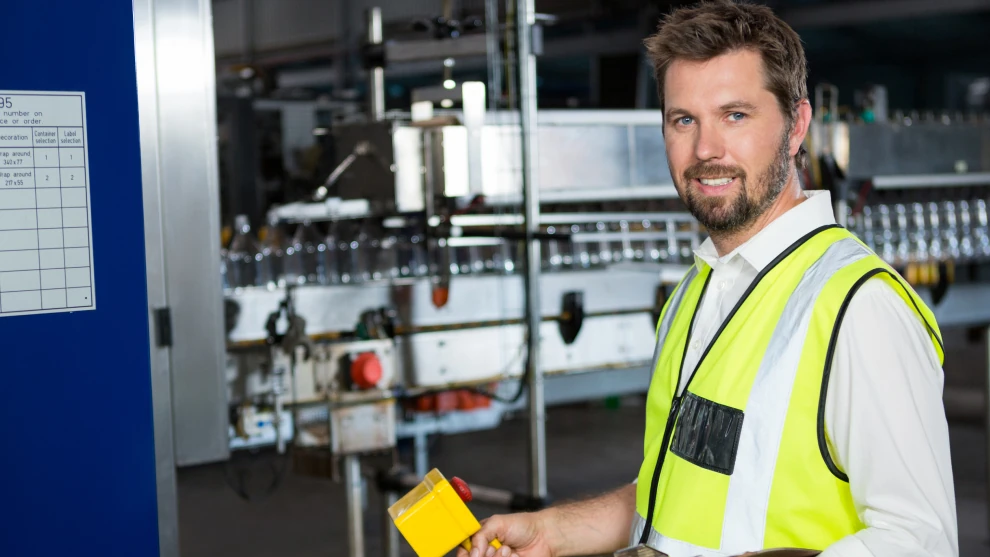
Implementing strategies to reduce maintenance costs and downtime is necessary for companies to maintain profitability and keep their systems running smoothly.
Below we discuss the process of planning, scheduling and efficient use of resources as an integral part of your key strategies to reduce maintenance costs and downtime.
Planning and scheduling
Effective maintenance task planning and scheduling is vital for minimizing downtime and work interruptions.
Here are some strategies for optimizing maintenance schedules and resource allocation:
- Prioritize tasks and projects respective to their importance and urgency.
- Plan maintenance activities in accordance with seasonal fluctuations and unplanned changes in the production process.
- Keep an eye on the backlog to ensure that all tasks are completed in a timely manner.
With our intuitive order management software, you will never lose track of important maintenance tasks again. Find out more here!
Efficient use of resources
The practical meaning of efficient use of resources is:
- More efficient management behind planning and maintenance strategies
- Omitting preventive maintenance tasks without added value
- Introducing proactive, forward-looking practices
- Improving productivity of maintenance activities.
These steps can sustainably reduce maintenance costs and minimize downtime during maintenance.
Industry-specific maintenance practices
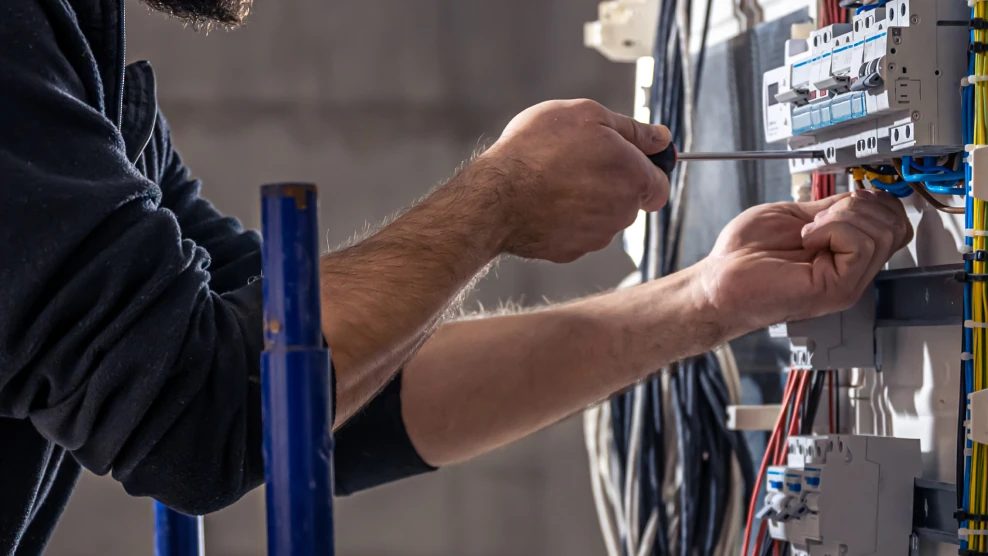
Each industry demands its own maintenance practices to ensure equipment works optimally for a long time. In this section, we examine industry-specific maintenance practices for:
- Building management
- Manufacturing
- Real estate
- The food and beverage sector
Building management
Building management tasks include specific maintenance procedures such as:
- Automation and servicing of assets
- Implementing a maintenance plan
- Investing in efficient management technology
- Using data analysis for information and statistics-based decisions
- Creating building management checklists
These practices help to ensure the safe and efficient operation of buildings and facilities.
Production & manufacturing
Maintenance measures during manufacture are vital in avoiding downtime while maintaining production efficiency. Some maintenance procedures, common in the manufacturing industry, include:
- Regular inspections to identify potential issues
- Preventive maintenance to keep all systems in optimum condition
- Planned production shutdowns, allowing technicians to carry out thorough inspection
- Regular production process monitoring to check the manufacturing performance
Real estate industry
In the real estate industry, maintenance and repair ensure that the value of the property is preserved and tenants are kept satisfied.
Common practices in the real estate industry include:
- Regular inspection & servicing
- Pest control
- Checking for water damage or leaks
- Ensuring that the systems are working properly
These practices help to maintain the value of the property and to ensure a high degree of tenant satisfaction.
Food and beverage industry
In the food and beverage industry, maintenance practices are essential to maintain hygiene standards and prevent equipment failure.
The critical aspects include:
- Meticulous attention to detail in maintenance management
- Continuous equipment upgrades and improvement
- Strict quality control measures
- Maintaining an immaculate working environment
These practices are vital for smooth operation and success of companies in the food and beverage industry.
Optimizing maintenance processes by using software
Maintenance tasks implementation can be optimized significantly with software. Put an end to paperwork using a central platform, where all relevant information is stored and evaluated.
Software can be used to plan the maintenance interval for your technical equipment, to monitor and document progress on all related tasks. Not only does it ensure all necessary maintenance work is carried out in accordance with regulations, it also significantly increases efficiency and helps to complete everything on time.
Software solutions offer a streamlined approach to managing operations and raising efficiency. The most important functions of maintenance software include:
- Testing & planning of procedures
- Establishing the current status
- Monitoring and managing work orders
- Keeping records of maintenance activities
- Using checklists and maintenance logs
With Wowflow software, you can plan maintenance tasks and continuously monitor and document work in progress. Create a free account here.
The future of maintenance: technology and innovation
The future of maintenance, servicing and repair looks very promising, with the introduction of technologies and innovations such as automation, IoT and AI-supported analytics. These advances are changing the way maintenance tasks are carried out and managed, leading to improved efficiency, fewer human errors and lower maintenance costs.
Here you will find a detailed analysis of these technologies and their impact on maintenance processes.
Automation and IoT
Automation and IoT play an important role in modern maintenance practices by increasing efficiency and reducing human error. Automation enables the rationalization of data collection, storage and analysis, as well as remote inspection and the superseding of certain tasks.
IoT boosts efficiency by improving the accuracy of inventory management, increasing productivity, reducing downtime and raising operational reliability.
AI-driven predictive analytics
AI-driven predictive analysis uses artificial intelligence algorithms and predictive models to evaluate device data and predict maintenance requirements. This advanced technology allows companies to identify potential problems before they lead to equipment failure, optimizing maintenance schedules and resource allocation.
AI-based predictive measures can lead to better availability, lower inspection costs and better decision-making.
Summary
Maintenance is an essential aspect for extending the service life of devices, ensuring optimum performance, minimizing costs and downtime.
Understanding the different types of maintenance, performing key tasks for common devices and leveraging technologies and innovations such as automation, IoT and AI-powered predictive analytics can help organizations effectively manage their maintenance operations and reduce overall costs.
Remember that proper maintenance is the key to long-lasting performance of your equipment and a successful business.
Frequently asked questions
How often should preventive maintenance be carried out?
Preventive maintenance should be carried out regularly, either time-based or usage-based, depending on the situation.
What are the benefits of regular maintenance of air conditioning systems?
Regular maintenance of air conditioning systems can improve efficiency, extend service life and maximize performance, resulting in long-term savings, reliability and comfort.
What are the most important functions of maintenance software?
Maintenance software makes it easier to plan maintenance related work, to manage work orders and to store data, enabling proactive maintenance strategies.
